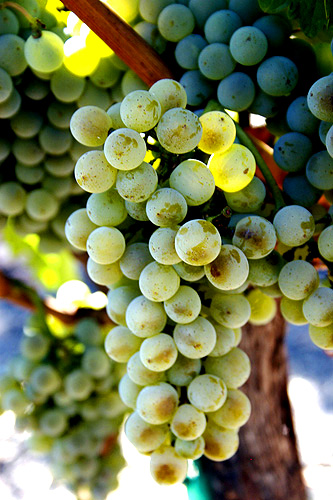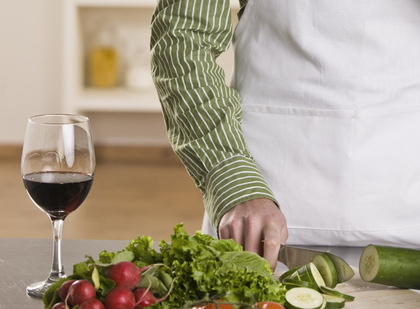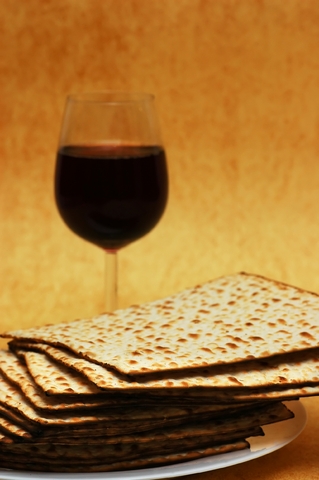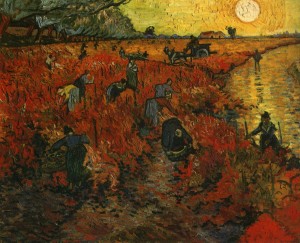by Lorri | Nov 4, 2009 | UnCorked
After many years of debate among wine writers, “terroir” continues to be one of the most discussed wine terminologies. Is it important to the consumer or simply another confusing term? I am one for the magic lure of terroir, believing grapes can be planted anywhere but grapes for great wines have a magical taste, boasting their perfect site on earth.
Terroir is the natural environment of the place a grape is grown. Another way of putting it is micro-climate, the trilogy of soil, climate and grape variety. But topography, daily temperatures, rainfall, mineral composition, plant vigor, sunlight and even whether the grapes are growing in a valley or on a hillside all contribute to the grape’s characteristics.
The climate, including temperature, influences the quality and styles of the wine. The temperature of the climate determines exactly which grapes will thrive, which won’t ripen and which will over-ripen.
Grapevines need soils that will drain excess water, store moisture and force the vines to grow deep into the ground, gaining minerals along the way. Perfect soils for winemaking are not necessarily the most fertile. Quality grapes can be found growing among weeds and olive trees in areas that would be considered inhospitable for other crops.
So a certain grape growing in the consummate soil mix with the perfect climate is the essence of terroir.
Historically, the French voiced strong opinions about terroir. This is likely because most French vineyards were small and the distinct differences in taste between two wines of the same type were easily noticed, whereas outside of Europe most vineyards were large plantings and the differences were less prominent. Today, many in the world embrace the belief in terroir, noting that a sauvignon blanc from Sancerre tastes completely different from the acidic green-apple tastes from New Zealand, and that chardonnay from Burgundy tastes much different from California’s Napa Valley expression.
Is one better than the other? Explore for yourself.
But I think discovering the terroir of wines is a magical journey in itself.
Bordeaux, France
THE VALUE
- 2007 Chateau Bonnet Sauvignon Blanc, France (about $12 retail)
THE SPLURGE
- 2006 Chateau Lascombes Margaux, France (about $150 retail)
New Zealand, South Island, Marlborough
THE VALUE
- 2008 Spy Valley Sauvignon Blanc, New Zealand (about $17 retail)
THE SPLURGE
- 2007 Cloudy Bay Sauvignon Blanc, New Zealand (about $39 retail)
Coonawarra, South Australia
THE VALUE
- 2007 Lindemans (Coonawarra) Shiraz / Cabernet Sauvignon , Australia (about $13 retail)
THE SPLURGE
- 2006 Jim Barry McRae Wood Shiraz, Australia (about $57 retail)
Napa Valley California
THE VALUE
- 2007 Martin Ray Napa Valley Cabernet Sauvignon, California (about $25 retail)
THE SPLURGE
- 2006 Bell Napa Valley Cabernet Sauvignon , California (about $86 retail)
by Lorri | Oct 28, 2009 | UnCorked
 Semillon (sem-ee-yon) is a chameleonlike wine. It can be bone dry, rich with ripeness or lusciously sweet. Many consumers are confused by its unusual name and wonder whether semillon is a grape or a French wine region. It is a grape, but much different from others of wider name recognition.
Semillon (sem-ee-yon) is a chameleonlike wine. It can be bone dry, rich with ripeness or lusciously sweet. Many consumers are confused by its unusual name and wonder whether semillon is a grape or a French wine region. It is a grape, but much different from others of wider name recognition.
You may find semillon hidden behind a French Sauternes label or lost within a blended wine. The grape is widely cultivated in Australia and Chile, as wine lovers continue demanding quality wine for less than $10 a bottle.
Few producers let the grape shine on its own, but Hunter Valley has created an exceptional following for those seeking this grape solo. It is dry when young but after about 10 years begins tasting like rich buttery marmalade. Barossa Valley offers a different style with a more steely lime character.
Semillon grapes can produce a great wine, and it is in France’s Sauternes and Barsac regions that this greatness is most often revealed. The grape has a very thin skin, making it perfectly susceptible to noble rot or Botrytis cinerea, a fungus that growers welcome. Well-ripened semillon grapes are blended with sauvignon blanc. Semillon adds weight and the ability to age in oak while sauvignon blanc brings acidity and flavor.
THE VALUES
- 2007 Lindemans Bin 77 Semillon-Chardonnay, Australia (about $10 retail)
- 2008 Jacob’s Creek Winery Semillon-Sauvignon Blanc, Australia (about $11) 2008 Penfold’s Rawson Semillon-Sauvignon Blanc, Australia (about $8)
- 2008 Rosemount Estate Semillon–Chardonnay, Australia (about $9)
THE SPLURGES
- 2007 Cape Mentelle Sauvignon Blanc–Semillon, Australia (about $23)
- 2007 Leewin’s Sibling Semillon-Sauvignon Blanc, Australia (about $22)
- 2005 Chateau Haut-Bergeron Sauternes, France (about $39)
- 2000 Chateau D’Armajan Sauternes, France (about $40)
by Lorri | Oct 21, 2009 | UnCorked
 When it comes to pairing wine and food the most important step is identifying the dominant flavor in the food. However, keep in mind the dominant flavor isn’t necessarily the main ingredient. Sometimes it is a spice or a flavor in the sauce.
When it comes to pairing wine and food the most important step is identifying the dominant flavor in the food. However, keep in mind the dominant flavor isn’t necessarily the main ingredient. Sometimes it is a spice or a flavor in the sauce.
The next step is to focus on the food’s key details — weight, acidity, saltiness, sweetness, texture and flavor intensity.
Weight is the most important component to consider. Instead of thinking white wines with fish and red wines with meat, consider rich foods with rich wines and subtle flavors with light wines.
Examples of rich, robust flavors include beef, lamb, duck, venison, mushrooms, garlic and strong spices such as rosemary or oregano. Also, cooking techniques such as grilling or roasting call for lustier wines.
Light flavors include chicken, veal, fish, pork, and delicate herbs. Cooking methods like steaming, stir-frying or baking call for more nuanced wines.
Wines with high acidity pair best with tart or sour foods. The pairing will complement the food and the wine will taste bright and fresh. Examples of such include dishes with lemon or orange sauces, fresh tomatoes, fresh lemon or lime and feta cheeses.
Saltiness is enhanced by a touch of sweetness or sparkle. Ideal pairings include Roquefort cheese and Sauternes, caviar and Champagne, oysters and sparkling wine, salted mixed nuts and fino sherry or olives and manzanilla sherry.
Tannin is often referred to when describing a wine’s texture. Red wines play the most integral role in food enhancement. If a food is high in fat it will coat the mouth, and tannin’s role is to strip the fat and ready the palate for the next sumptuous bite.
Finally there’s flavor intensity. Intensely flavored wines can be used to contrast rich foods or simply complement the flavor. For example, lightbodied Rieslings or Gewurztraminers are intensely flavored wines and can be used to cut through rich foods such as a curry sauces.
THE VALUES
- Weight: Rich, robust flavors 2007 Root 1 Cabernet Sauvignon Blanc, Chile (about $12 retail)
- Acidity 2008 Casillero Del Diablo Sauvignon Blanc, Chile (about $14 retail)
- Saltiness NV Freixenet Cordon Negro Brut, Spain (about $15 retail)
- Texture 2008 Yali Cabernet Sauvignon, Chile (about $10 retail)
- Flavor intensity 2007 Bloom Riesling, Germany (about $10 retail)
THE SPLURGES
- Weight: Rich, robust flavors 2006 Trapiche Oak Cask Malbec, Argentina (about $16 retail)
- Acidity 2007 Spy Valley Sauvignon Blanc, New Zealand (about $18 retail) Saltiness NV Roederer Estate Brut, California (about $22 retail)
- Texture 2006 Ridge Lytton Springs Zinfandel, California (about $40 retail) Flavor intensity 2005 Hugel Riesling, France (about $26 retail)
by Lorri | Oct 14, 2009 | UnCorked
It’s time to share another page from the memoirs of a tired, teeth-stained wine taster. The recent event, Festival of Wines benefiting the Arkansas Heart Association, offered an exciting tasting experience. Dickey-Stephens Park was filled with an extensive selection of wines ranging from $5 merlots to $200 one-of-a-kind cult wines.

Arriving with my palate fresh and the Uncorked column as my motivation, I fell in line with other guests to explore and enjoy. Following are only some of the wines catching my attention, not only for quality but exceptional value.
THE VALUES
- 2007 Arido Malbec, Argentina (about $10 retail)
- 2007 Andeluna Malbec, Argentina (about $10 retail)
- 2007 337 Cabernet Sauvignon, California (about $10 retail)
- 2008 337 Cabernet Sauvignon, California (about $12 retail)
- 2007 Solena Pinot Gris, Oregon (about $12 retail)
- 2008 Solena Pinot Gris, Oregon (about $12 retail)
- 2008 Santi Pinot Grigio, Italy (about $15 retail)
- 2008 Il Conte Stella Rosa, Italy (about $15 retail)
- 2007 Codice Tempranillo, Spain (about $10 retail)
- 2007 Paso A Paso Verdejo, Spain (about $12 retail)
- 2007 Paso A Paso Tempranillo, Spain (about $12 retail)
- 2008 Yali Sauvignon Blanc, Chile (about $12 retail)
- 2007 La Playa Block Estate Reserve Carmenere, Chile (about $12 retail)
- 2007 Cupcake Sauvignon Blanc, New Zealand (about $12 retail)
- 2008 Oyster Bay Sauvignon Blanc, New Zealand (about $15 retail)
THE SPLURGES
- 2007 Maddalena Cabernet Sauvignon, California (about $16 retail)
- 2007 Botani, Spain (about $19 retail)
- 2006 Volver Tempranillo, Spain (about $18 retail)
- 2006 Solena Grande Cuvee Pinot Noir, Oregon (about $27 retail)
- 2006 Bell Wine Cellars Syrah, California (about $28 retail)
- 2005 Schug Sonoma Merlot, California (about $38 retail)
- 2007 Spann Vineyards Chardonnay/ Viognier, California (about $27 retail)
- 2006 Bell Wine Cellars Chardonnay, California (about $39 retail)
by Lorri | Oct 7, 2009 | UnCorked
 Several readers have inquired about kosher wines recently. And while Rosh Hashana and Yom Kippur have passed, kosher wines aren’t just for holidays.
Several readers have inquired about kosher wines recently. And while Rosh Hashana and Yom Kippur have passed, kosher wines aren’t just for holidays.
Many outside the Jewish community seek kosher wines because of the “bio” friendly production and the strict winemaking practices which include the prohibition of any animal products such as egg whites or gelatin which are sometimes used as fining agents to clarify wine.
The grapes must be from vines that are at least 4 years old and every seventh year the fields must be left uncultivated. There are also strict prohibitions on other crops being grown in the same vineyards.
During the harvest only Sabbath-observing male Jews are allowed to work the vineyards and winery and a rabbi or kashrut-trained supervisor — one versed in the Jewish dietary laws — must observe all steps in the winemaking process.
Following production, 1 percent must be thrown away, a symbolic remnant of the 10 percent tithe, paid to the Temple in Jerusalem.
There are two different types of kosher wines, meshuval and nonmeshuval. Meshuval wine has been heated to near the boiling point, then cooled. This ensures the wine is kosher regardless of how and by whom it is served.
Nonmeshuval wine has not been boiled. If the person who opens or serves the wine is not Jewish, the wine is no longer kosher.
With increased quality and producers including vineyards in France, Spain, California, Italy, New Zealand and Israel, there are many excellent kosher wines to be found. The following are available in Arkansas.
THE VALUES
- 2007 Kesser Concord, New York (about $7 retail)
- 2007 Recanati Cabernet Sauvignon, Israel (about $16 retail)
- 2007 Baron Herzog Chardonnay, California (about $19 retail)
THE SPLURGE
- NV Laurent Perrier Brut, France (about $75 retail)
by Lorri | Sep 30, 2009 | UnCorked
I like to read about wine almost as much as I enjoy drinking it, and a recent trip to the bookstore turned up a provocative wine book on price and its correlation to quality.
The Wine Trials by Robin Goldstein has surprising results from “brown bag” blind tastings. At a brown bag tasting, the wine bottle is literally covered in a brown bag so the taster cannot see any part of the bottle.
The book is the result of 17 blind tastings that were held around the country in 2007 and 2008. They invited more than 500 tasters ranging in age from 21 to 88 and in professions that included wine critics, winemakers, sommeliers, professors, doctors and lawyers. The tasters included everyday wine drinkers and occasional wine drinkers.
The results?
“On the whole, tasters preferred a nine-dollar Beringer Founders’ Estate Cabernet Sauvignon to a $120 wine from the same grape and same producer: Beringer Private Reserve Cabernet Sauvignon. They preferred a six-dollar Vinho Verde from Portugal to a $40 Cakebread Chardonnay … and when we concealed the labels and prices of 27 sparkling wines and asked people to rate them, the Dom Perignon finished 17th — behind 14 sparkling wines that cost less than $15, eight of which cost less than $10.”
The results make sense if you consider the majority of wine drinkers are everyday drinkers and not seasoned collectors or experts. However, the trials did show that experts or those with wine training and experience rated more expensive wines differently and scored them higher than others on the panels.
The following is a selection of some of The Wine Trials’ 100 recommended wines under $15 that beat $50 to $150 wines in the brown bag tastings. Most have appeared as Value recommendations in past Uncorked columns. Taste for yourself — with a brown bag or without.
12 WINES UNDER $15
- 2008 Alice White Chardonnay, Australia
- NV Domaine Ste. Michelle Brut, Washington
- 2007 Mark West Pinot Noir, California
- 2007 Paul Jaboulet Aine Parallele 45 Cotes du Rhone, France
- 2007 Campo Viejo Rioja, Spain
- 2008 Oyster Bay Sauvignon Blanc, New Zealand
- 2008 Crane Lake Sauvignon Blanc, California
- 2007 Fetzer Valley Oaks Merlot, California
- 2007 Concannon Petite Sirah, California
- 2007 Trapiche Malbec, Argentina
- 2007 Rosemount Shiraz, Australia
- NV Freixenet Cordon Negro Extra Dry, Spain




